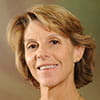Self-Massage for IT Band Syndrome
There’s more to foam rolling when dealing with IT band symptoms
You wrap up a hard breaststroke set or 5-mile run and are later assaulted by pain and/or a burning sensation on the outside of the knee. The first impulse is to blame the knee joint. Few people consider or might not even know much about the iliotibial band, which often becomes inflamed or irritated after high-intensity, lower-extremity activities. The good news is that outer knee pain related to the iliotibial band, known as IT Band Syndrome, can often be remediated with self-massage.
The iliotibial band is “a thick band of connective tissue that originates from the tensor fascia latae [thigh muscle] and runs down the side of the thigh and across the knee,” says Austin-based physical therapist and massage therapist Kendal Jacobson. Specializing in the evaluation and rehabilitation of orthopedic and sports injuries, Jacobson is also an avid Masters swimmer.
When experiencing discomfort, many people attack the ITB with a foam roller or other self-massage tool, imagining that alone will alleviate the pain. However, this might not be helpful because of how interrelated the muscles and tissues of the legs are—all connected by tissue known as fascia.
“No one structure is isolated,” says Jacobson. “Our fascial system is interconnected. Fascia of the quad and hamstring and gluteals have an effect on the fascial tension of the ITB. Weakness of the gluteus medius or maximus or the deep external rotators of the hip can effect the position of the pelvis and the leg in stance, so there is the potential for tendinitis of the gluteus medius in conjunction with ITB syndrome.”
Determining the reason for the IT band issue is as important as treating it, says Jacobson. “Abdominal recruitment and pelvic alignment can affect how the hip joint is aligned and fascial tension patterns of the hip and thigh. This in turn can contribute to fascial restrictions of the IT Band. However, fascia is not just inert connective tissue ‘shrink wrap’ that holds us together; it has a neural component and, therefore, self-massage of the IT band (or any contractile soft tissue) can have an effect on your ability to recruit or contract a muscle.”
When performing self-massage with a foam roller, Jacobson recommends that people start at the lateral aspect [side] of the pelvis (over the tensor fasciae latae [thigh muscle] and gluteus medius [the lateral muscles that stretch over the hips]). By performing a “sawing motion,” rather than a “rolling pin” technique, “this creates shear on the fascia that helps release adhesions and increases blood flow.” A similar technique can be applied to the anterior and lateral quad as well as the central and lateral hamstring where it blends into the ITB. “I rarely have people roll directly on the ITB,” Jacobson says. “The pain versus reward ratio doesn’t work out.”
Pressure should be at a level that allows relaxation on the roller. Because bodyweight is directly proportional to the pressure an individual experiences when perched on top of a roller, Jacobson suggests heavier individuals work on a soft surface such as a mat, bed, or even against a wall.
Jacobson advocates self-massage for recovery. “A recent study showed that foam rolling immediately after, 24 hours post-[intense exercise], and 48 hours post-[intense exercise], helped to decrease delayed onset muscle soreness and improve sprint, power, and dynamic strength-endurance as compared to a control group following an intense exercise bout.”
When pain persists, a qualified professional should be sought. “Arthritis in the hip or knee joint, patellofemoral pain syndrome [pain originating in kneecap joint], and lumbar radiculopathy [nerve compression from a disc bulge],” are other conditions that might incite lateral knee pain, Jacobson says.
“A good sports medicine specialist can help you sort through what is causing your pain and solve the root of the problem and not just chase symptoms.”
Categories:
- Health and Nutrition















